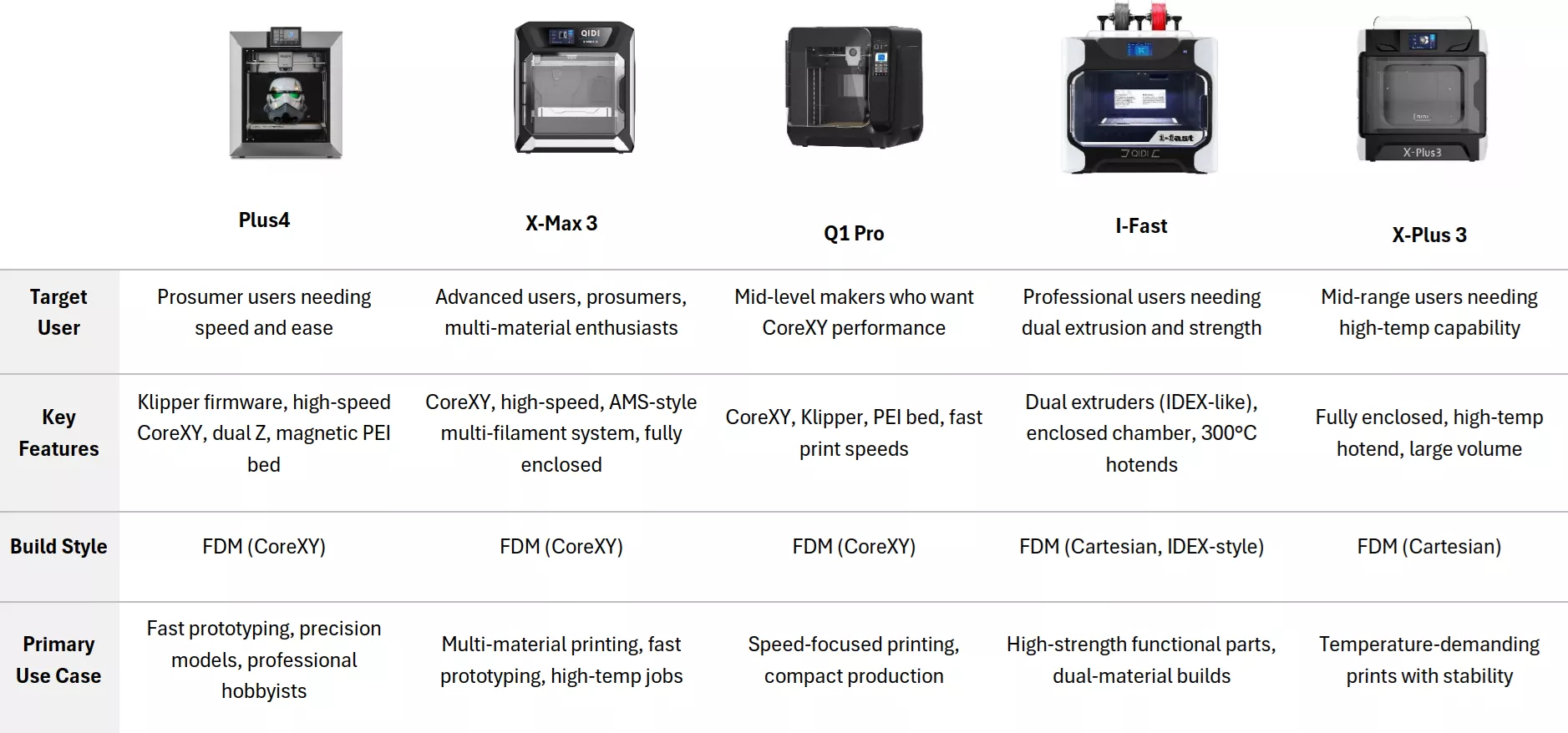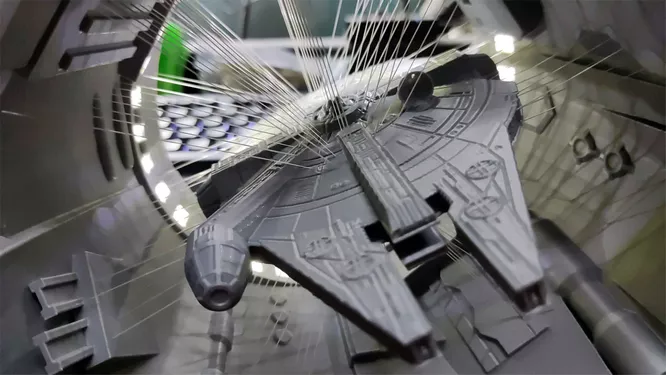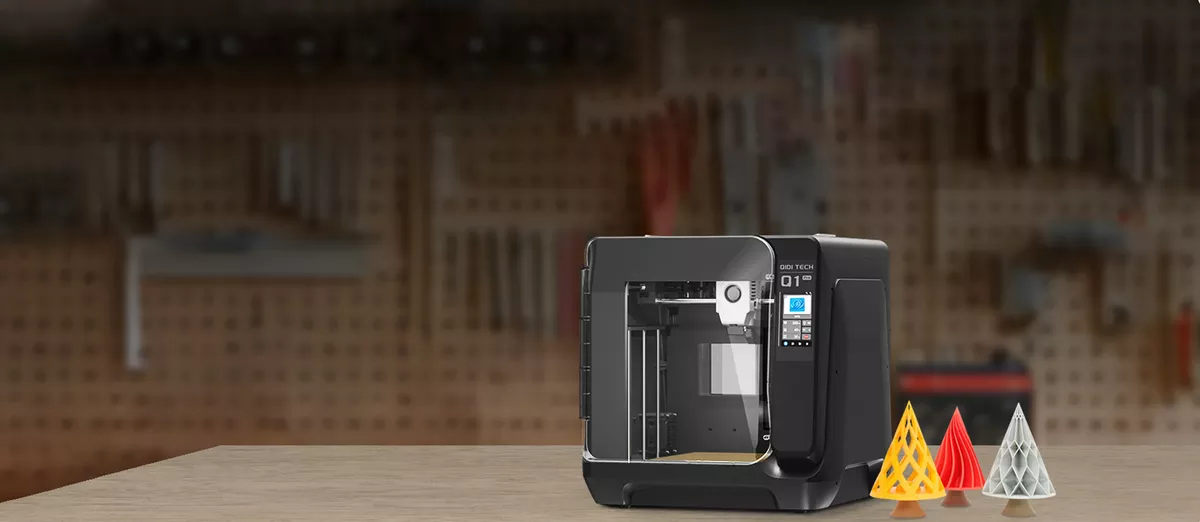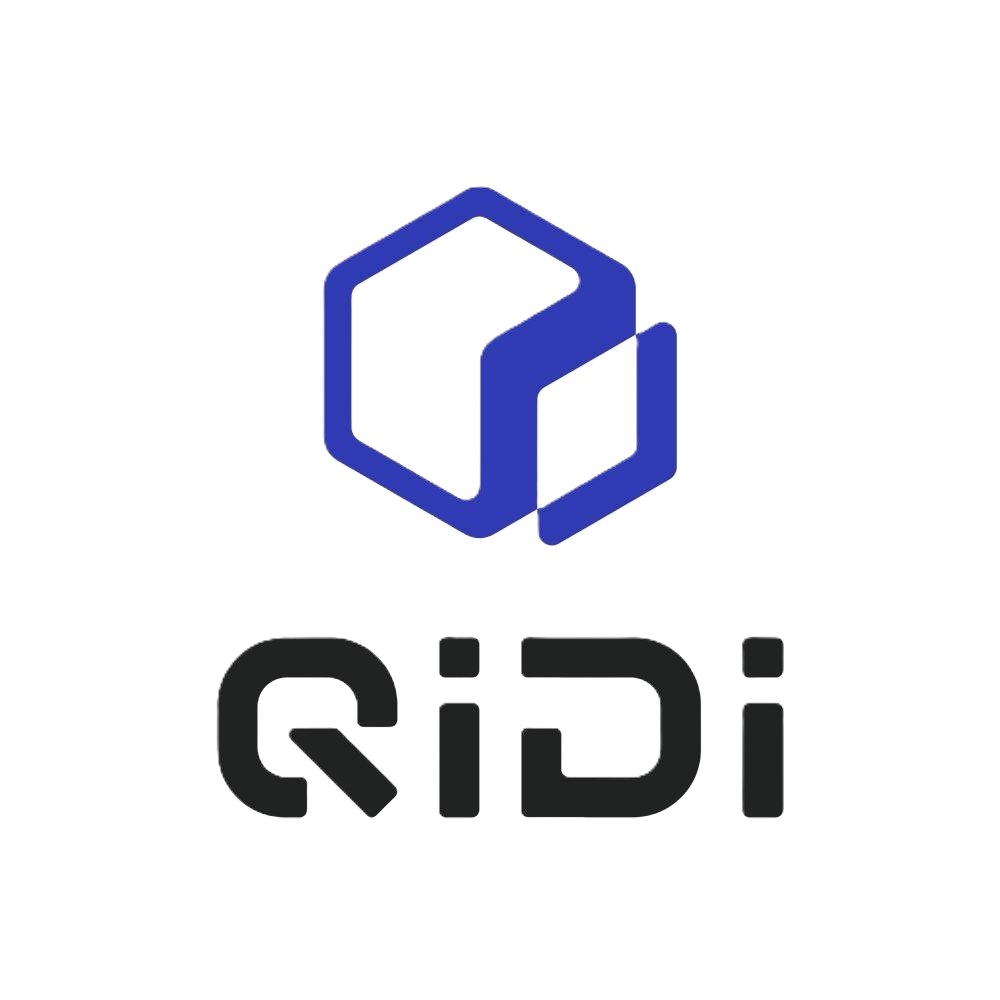Highlights
Excellent print quality even at high speeds, especially on CoreXY models
Advanced multi-material support with dual extruder options in some models
Fully enclosed designs for better material compatibility and print reliability
Strong out-of-the-box usability with auto-bed leveling and easy touchscreen interfaces
Wide filament compatibility (PLA, PETG, TPU, ABS, Nylon, PC)
Industrial-grade build quality in higher-end models like X-Max 3 and i-Fast
Reliable ecosystem with good firmware support and regular updates
Competitive pricing for semi-professional and professional-grade features

Founded in 2014, QIDI Tech has steadily established itself as one of the most trusted brands in the mid to high-end consumer 3D printing market. Known for its focus on fully enclosed, professional-grade machines (enclosed printers have a surrounding structure that traps heat and improves safety and material compatibility), QIDI bridges the gap between hobbyist and industrial 3D printing with printers that prioritize reliability, material versatility, and user-friendly interfaces. With a product range that spans from compact, beginner-friendly machines like the X-Smart 3 to high-performance beasts like the X-Max 3 and i-Fast, QIDI consistently delivers printers that are well-built, thoughtfully designed, and capable of tackling complex, high-temperature materials (like nylon or carbon-fiber blends, which need stable, heated environments). Their recent move toward CoreXY architectures (a fast and stable printer design that separates X and Y axis motors) and faster printing speeds shows their commitment to evolving alongside industry trends, while still maintaining an emphasis on ease of use and consistent quality.
Product Selection
4.2 /5
QIDI combines industrial-grade features with consumer-friendly pricing, especially in enclosed CoreXY machines. From prosumer builds to multi-material setups, it’s tailored for users who want high performance with polish.

Ease of Use
4.5 /5
Ease of use is a major strength for QIDI Tech. Printers are typically delivered almost fully assembled, with clear instructions, responsive touchscreens, auto-bed leveling (a sensor-guided system that ensures the print bed is perfectly level before starting), filament detection (which pauses the print if filament runs out), and user-friendly proprietary slicers like QIDI Print (a slicing software customized for QIDI printers). Software setup is straightforward, and print profiles are well-optimized for QIDI machines, minimizing the need for manual tuning. Firmware updates are regular and generally smooth, though users expecting highly customizable, open-source experiences might find QIDI’s ecosystem a little restrictive. Still, for most users, the experience is very polished and beginner-friendly.
Cost & Affordability
3.6 /5
Pricing for QIDI printers is highly competitive considering their feature sets. Entry-level models like the X-Smart 3 start around $350–$400, mid-range machines like the X-Plus 3 and Q1 Pro sit between $600–$1,000, and high-end units like the X-Max 3 and i-Fast stretch toward $1,500 or slightly more. For users seeking serious capability without jumping into full industrial-class machines, QIDI offers a very appealing value proposition, particularly given their material support and print quality.
Print Quality & Speed
4.4 /5
QIDI printers are well regarded for delivering excellent print quality across their lineup. Whether it’s the X-Plus 3, X-Max 3, or Q1 Pro, users frequently report crisp details, smooth surface finishes, and strong dimensional accuracy (ensuring prints match design measurements) even at higher speeds. CoreXY models like the X-Max 3 and Q1 Pro are capable of printing at 600 mm/s or more, with minimal compromise in quality thanks to strong mechanical design and advanced vibration compensation (a feature that reduces print artifacts caused by printer shaking during fast movements). However, earlier models like the X-One 2 are slower and prioritize stability over raw speed. Across the board, QIDI consistently achieves a balance of speed and precision, particularly with properly tuned slicer profiles (preset settings used to convert 3D models into printable layers).

Material Compatibility
4.6 /5
QIDI printers shine when it comes to material flexibility. Most models can easily handle PLA (a popular biodegradable filament), PETG (strong and heat-resistant), and TPU (flexible rubber-like filament), while enclosed models like the X-Plus 3, i-Fast, and X-Max 3 are specifically designed to print demanding filaments like ABS (a durable, impact-resistant plastic), Nylon, PC (polycarbonate), and even CF composites (carbon fiber-infused filaments, which are strong and lightweight). Machines typically include dual extruder setups—featuring both direct drive extruders (for better handling of flexible filaments) and high-temperature variants—and often come with easy-swap hotends (modular parts that melt and extrude filament). This design makes it easy to switch between low and high-temperature materials efficiently. The fully enclosed chambers and high-temperature capabilities significantly widen material options, positioning QIDI ahead of many similarly priced competitors.

Build Volume & Variety
4.1 /5
QIDI offers a good range of build volumes suited for different users. Compact models like the X-Smart 3 are ideal for small workspaces and personal projects, while the X-Plus 3 and X-Max 3 offer mid to large-format printing areas (up to 325 x 325 x 315 mm, large enough for functional parts, cosplay pieces, or multi-part assemblies). The i-Fast goes even bigger and supports dual-material prints with its independent extruders (extruders that move separately, allowing simultaneous prints with different materials or colors). This range allows QIDI to cover everything from hobbyist desktop needs to small-batch production or prototyping projects, maintaining versatility across their portfolio.
Reliability & Durability
4.3 /5
QIDI printers are built to last, particularly the newer generations. Models like the X-Max 3 and i-Fast feature sturdy metal frames, enclosed designs, dual linear rails (parallel motion guides that enhance stability), and strong cooling systems that support extended print runs with minimal downtime. The overall mechanical reliability is excellent, though occasional user reports point to minor issues like fan failures or touchscreen glitches, which are usually resolved quickly by responsive customer support. Across long-term use, QIDI printers tend to hold up well with minimal intervention.
Maintenance
3.9 /5
Maintenance requirements for QIDI printers are moderate and generally predictable. Nozzle swaps, belt tensioning, and bed maintenance (cleaning or replacing the build surface) are straightforward thanks to accessible designs. Spare parts and hotend replacements are readily available, and firmware updates often include new features and bug fixes. However, advanced repairs on components like the extruder or motion system may require more effort due to the enclosed nature of most models. Nevertheless, for day-to-day use, maintenance is simple and infrequent.
Technology & Features
4.4 /5
QIDI has consistently packed its machines with advanced features relative to their price. CoreXY kinematics, automatic bed leveling, high-temperature dual extruders, filament runout sensors, resume printing (a feature that restarts prints after a power outage), and enclosed heated chambers are standard on many models. Newer units support faster print speeds and better print quality with upgraded processors and silent stepper drivers (which reduce noise and improve motion precision). The brand’s slicer, QIDI Print, is regularly updated and offers a clean, efficient workflow. While not entirely open-source, the software and hardware integration are well thought out, offering high-level functionality with minimal complexity for the user.
Conclusion
QIDI Tech occupies a strong position in the market, offering a professional-grade printing experience without the complexity or cost often associated with industrial machines. Their focus on reliability, material versatility, and user-friendliness makes them an excellent choice for serious hobbyists, small businesses, educators, and semi-professionals. While the ecosystem leans more proprietary than fully open-source platforms, the level of refinement, support, and performance QIDI delivers makes it a standout brand in the mid-to-high-end consumer 3D printing space.


